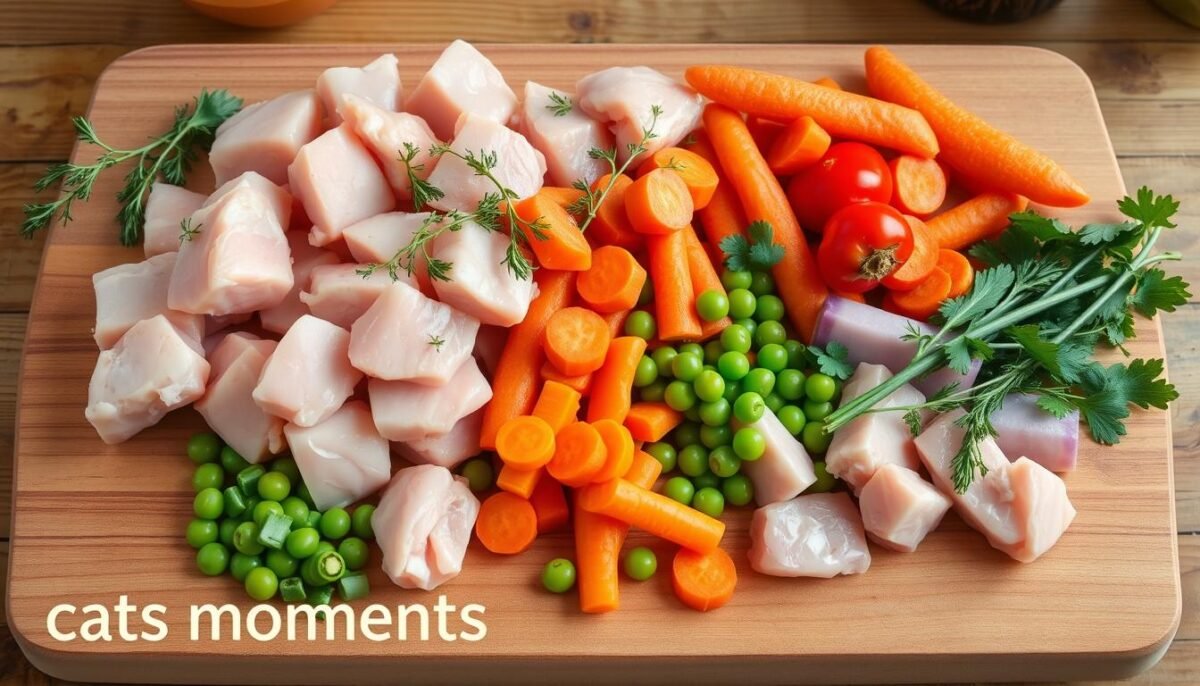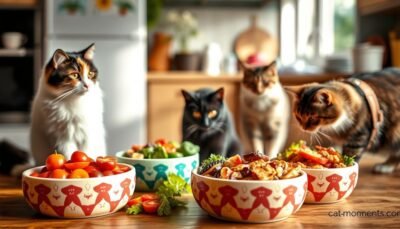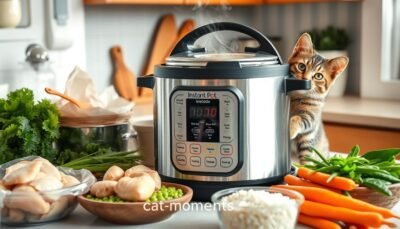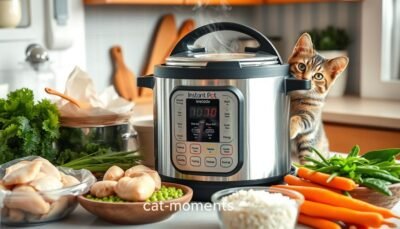More cat owners are choosing homemade cat food for their pets. They want to know why it’s better. We’ll explore how making food for your cat can change their life.
The pet food industry has long focused on mass production. But, pet owners are now taking charge of their cats’ diets. Homemade cat food ensures they get the right mix of nutrients for health.
We’ll look at the benefits, essential ingredients, and safety tips for homemade cat food. This guide will help you make the best choices for your cat’s meals.
Key Takeaways
- Homemade cat food offers superior nutritional value compared to commercial options.
- Preparing meals at home allows us to control the ingredients and tailor the diet to our cat’s specific needs.
- Proper safety measures and research are crucial when making homemade cat food to ensure your feline’s well-being.
- Transitioning to a homemade diet can be a gradual process, but the long-term benefits are well worth the effort.
- Consulting with a veterinarian is recommended to ensure your homemade cat food recipes are balanced and complete.
Benefits of Homemade Cat Food
Feeding our cats homemade meals has many benefits. We can give them a natural diet with high-quality ingredients. This meets their nutritional needs perfectly.
Improved Nutrition for Our Cats
Homemade cat food lets us control what our pets eat. We avoid harmful additives found in some commercial foods. This way, we support their health and well-being.
Control Over Ingredients
We can pick the exact ingredients for our cats’ meals. This lets us tailor their diet to their specific needs. We ensure they get the right mix of proteins, fats, and carbs.
Tailored Diet for Our Pet’s Needs
Every cat is different, and so are their nutritional needs. Homemade cat food allows us to make meals that fit their unique requirements. This way, we can help them stay healthy and happy.
The advantages of homemade cat food are clear. By controlling their diet, we ensure they get the best nutrition. This leads to happier, healthier cats.
Common Ingredients in Homemade Cat Food
When we make homemade meals for our cats, we need to pick the right ingredients. These ingredients should give a balanced diet. They include lean proteins, vitamins, and minerals that keep our cats healthy.
Lean Proteins We Should Use
Protein is key for a cat’s diet. We should choose lean, high-quality proteins. Good choices are:
- Chicken (cooked, boneless, and skinless)
- Turkey (cooked, boneless, and skinless)
- Lean ground beef (low in fat)
- Eggs (cooked)
- Fish (such as tuna, salmon, or whitefish)
These proteins give cats the amino acids they need to stay healthy.
Vegetables and Grains to Include
Cats also need vegetables and grains in their diet. Healthy choices are:
- Cooked sweet potatoes or pumpkin
- Steamed broccoli or green beans
- Cooked brown rice or oats
- Grated carrots or zucchini
These foods add vitamins, minerals, and fiber to support our cats’ health.
Essential Supplements for Nutrition
Even with a balanced homemade diet, supplements are important. Key ones are:
- Calcium (for bone health)
- Taurine (for heart and eye health)
- Omega-3 and omega-6 fatty acids (for skin and coat health)
- Probiotics (for digestive support)
Knowing what makes a balanced homemade cat diet helps us feed our cats well. By using lean proteins, vegetables, grains, and supplements, we can make tasty, healthy meals for them.
Safety Considerations for Homemade Cat Food
When we make food for our cats at home, we must focus on their health and safety. It’s our job as pet owners to make sure the food is clean and nutritious. Here, we’ll talk about important safety tips for making healthy cat food at home.
Ensuring Food Safety Standards
Keeping food safe is key when making homemade cat food. Always wash your hands before and during cooking. Make sure all tools, surfaces, and containers are clean and sanitized. Follow safe ways to thaw and store food to avoid harmful bacteria.
Avoiding Toxic Foods for Cats
Some human foods are bad for cats and can even be dangerous. When making homemade food, avoid onions, garlic, grapes, raisins, and chocolate. Talking to a vet or using reliable sources can help us know which foods are safe for healthy cat feeding and feline nutrition.
Proper Storage Techniques
Storing homemade cat food right is important for its freshness and safety. Always refrigerate or freeze meals in airtight containers. It’s also key to control portions to avoid spoilage and bacterial growth.
| Safety Considerations | Best Practices |
|---|---|
| Food Preparation |
|
| Ingredient Selection |
|
| Food Storage |
|
By focusing on these safety tips, we can make homemade cat food that’s good for their health and taste. Making sure we handle and store food properly shows we care about our pets’ well-being.
Recipes for Homemade Cat Food
Are you ready to take your cat’s meal preparation to the next level? Making homemade cat food is a rewarding way to feed your feline friend. We have three tasty recipes that are easy to make and full of nutrients your cat needs.
Simple Chicken and Rice Recipe
This classic mix of lean chicken and rice is a hit with cats. To make it, you’ll need:
- 1 lb boneless, skinless chicken breasts, cooked and shredded
- 2 cups cooked brown rice
- 1 tablespoon of fish oil or omega-3 supplement
- Multivitamin supplement (as directed on the package)
Mix the cooked chicken and rice together. Add the fish oil and multivitamin. Portion it out and refrigerate or freeze for later. This recipe is a balanced, protein-rich meal your cat will love.
Tuna and Pumpkin Delight Recipe
Try this tasty recipe with tuna and pumpkin for a twist on homemade cat food. You’ll need:
- 5 oz canned tuna, drained
- 1/2 cup canned pumpkin puree
- 1 tablespoon of ground flaxseed
- Calcium supplement (as directed on the package)
Mix the tuna, pumpkin, and flaxseed in a bowl. Add the calcium supplement. Serve this dish to your cat for a healthy dose of omega-3s, fiber, and minerals.
Beef and Vegetable Medley Recipe
This recipe is perfect for the carnivorous cat. You’ll need:
- 1 lb ground beef, cooked and drained
- 1 cup chopped carrots, steamed
- 1/2 cup frozen peas, thawed
- 2 tablespoons of bone broth or water
- Multivitamin supplement (as directed on the package)
Mix the cooked beef, carrots, and peas together. Add the bone broth or water to moisten. Stir in the multivitamin supplement. Portion and serve or store in the fridge or freezer for later.
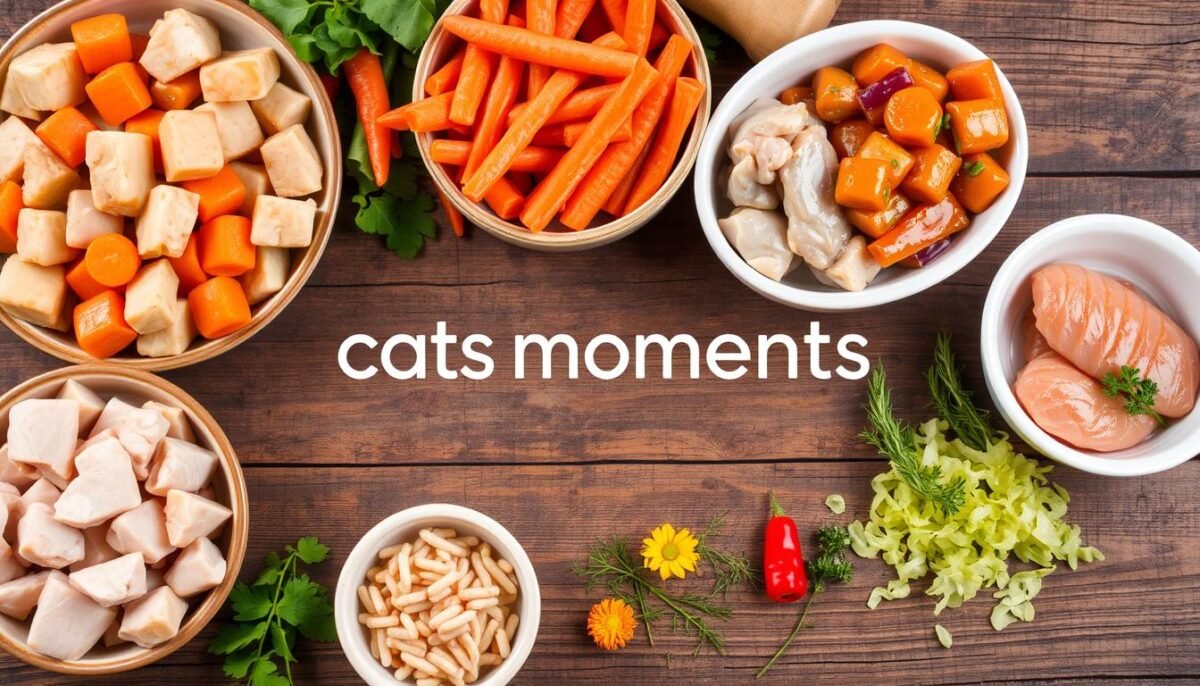
These three recipes offer a variety of flavors and nutrients for your cat. By making homemade cat food, you can give your feline friend the freshest, most wholesome meals.
Understanding Our Cat’s Nutritional Needs
As pet owners, knowing what our cats need is key. A natural cat diet must balance proteins, fats, carbs, vitamins, and minerals. These are vital for their health and happiness.
Proteins, Fats, and Carbohydrates
Cats need a lot of animal proteins because they are meat-eaters. These proteins help build their muscles and organs. Fats give them energy and keep their skin and coat healthy. But, cats don’t need much carbs compared to other pets.
Vitamins and Minerals We Should Consider
- Vitamin A: Crucial for vision, immune function, and skin health
- Vitamin B12: Supports red blood cell formation and neurological function
- Calcium and Phosphorus: Necessary for strong bones and teeth
- Taurine: An essential amino acid that supports heart and eye health
Hydration and Its Importance
Keeping our cats hydrated is very important. Since they don’t drink much, we need to make sure they always have fresh water. Dehydration can cause serious health problems, so we should encourage them to drink more.
Knowing what our cats need helps us feed them right. This way, we can keep them healthy and happy. By choosing a natural cat diet, we support their long-term health.
Transitioning Our Cat to Homemade Food
Switching our cat’s diet to homemade food is a gradual process. But the benefits are worth it. We can introduce new ingredients slowly and watch our cat’s response. This way, we ensure a smooth transition to a healthier diet.
Gradual Introduction Strategies
It’s important to take it slow when switching to homemade cat food. Start by mixing a small amount of homemade food with their current food. Gradually increase the homemade food over several weeks.
This slow approach helps our cat’s digestive system adjust. It prevents any stomach problems.
Monitoring Our Cat’s Response
- Watch our cat’s behavior and appetite closely during the transition.
- Look for signs of enthusiasm, such as eagerness to eat the new food or increased energy levels.
- Monitor any changes in our cat’s coat, skin, and overall health, ensuring a positive response to the homemade diet.
Adjusting Portions and Recipes
As we switch to homemade cat food, we might need to adjust portions and recipes. Pay attention to our cat’s response and make small changes. This ensures the homemade diet meets their nutritional needs.
| Transition Step | Recommended Approach |
|---|---|
| Initial Introduction | Mix 10-20% homemade food with 80-90% commercial food |
| Gradual Increase | Increase homemade food by 10-20% every 7-10 days |
| Full Transition | Reach 100% homemade food within 4-6 weeks |
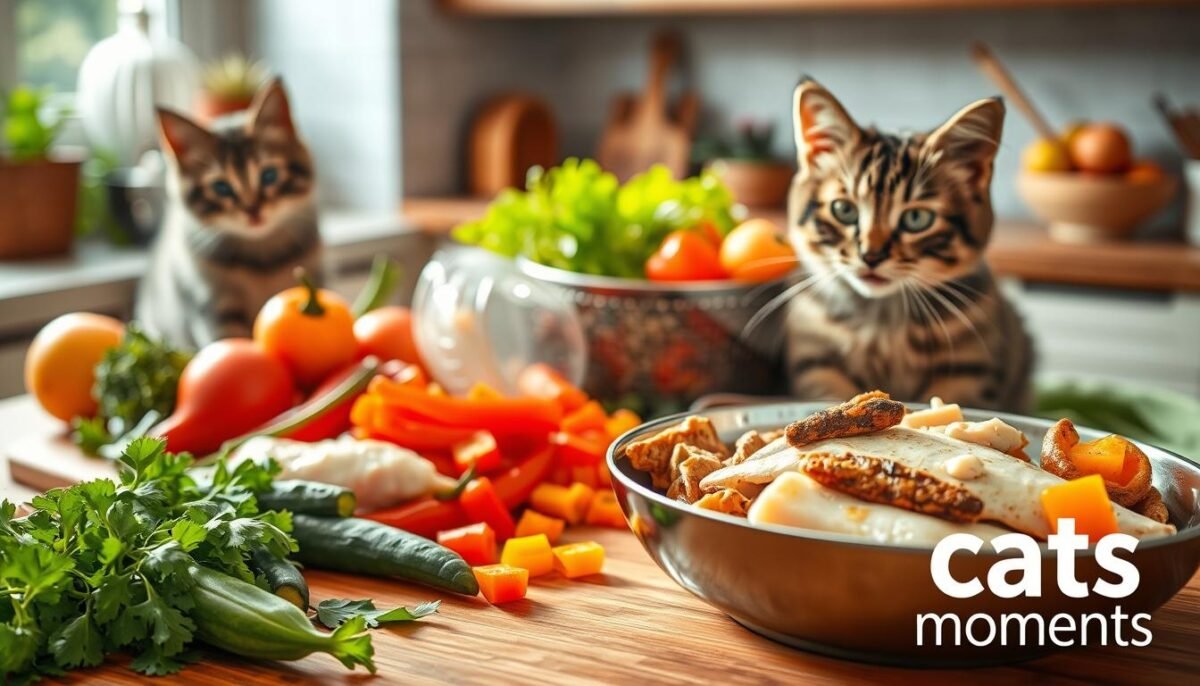
By following these strategies, we can smoothly transition to a homemade cat food diet. This provides our feline friend with the healthy cat feeding they deserve.
Tools and Equipment for Preparing Cat Food
Making tasty and healthy DIY pet meals for our cats needs the right tools. We want to give our cats the best care, which means making their food ourselves. Here are the kitchen tools, safety gear, and storage you need for a clean and organized space.
Essential Kitchen Tools We Need
- High-quality blender or food processor to puree ingredients
- Meat grinder or chopper for ground proteins
- Stainless steel mixing bowls and measuring cups for precise portioning
- Sturdy cutting boards dedicated solely for pet food preparation
- Sharp knives for chopping and dicing fresh ingredients
Food Safety Equipment
Keeping food safe is key when making homemade cat food. Here are some must-haves:
- Disposable gloves to prevent cross-contamination
- Sanitizing wipes or spray for cleaning surfaces
- Meat thermometer to ensure proteins are cooked to the appropriate temperature
- Refrigerator and freezer for storing prepared meals
Storage Solutions for Prepared Meals
It’s important to keep homemade cat food fresh and easy to access. Think about getting:
- Airtight containers or BPA-free storage bags for refrigerated portions
- Freezer-safe containers or zip-top bags for longer-term storage
- Labeled and dated containers to keep track of meal batches
With the right tools and equipment, we can make a clean and efficient space for making cat food. This way, our cats get the best homemade cat food easily.
Affordability of Homemade Cat Food
Looking after our cats can get expensive, especially with commercial pet food. But making homemade pet treats and organic cat food at home might be cheaper. Let’s look at how making our cat’s meals at home can save money.
Comparing Costs with Commercial Options
Buying organic cat food can cost a lot, especially for big cats or families with many pets. Making our own cat food can save a lot of money over time. We can pick cheaper ingredients and control how much we make, reducing waste.
Budget-Friendly Ingredients
- Lean proteins such as chicken, turkey, or lean ground beef
- Wholesome grains like brown rice or oats
- Affordable vegetables like carrots, spinach, or pumpkin
- Essential vitamins and minerals in the form of supplements
Long-Term Savings on Cat Health
Choosing homemade cat food can also save money on vet bills. A healthy diet can prevent problems like obesity and kidney disease. This can mean fewer vet visits and lower bills in the long run.
| Commercial Cat Food | Homemade Cat Food |
|---|---|
| $50 – $100 per month | $25 – $50 per month |
| Limited control over ingredients | Full control over ingredients |
| Potential for health issues | Improved feline health |
Thinking about the costs of homemade pet treats and organic cat food helps us make a smart choice. A homemade diet can offer long-term benefits, making it a good choice for pet owners.
Consulting Your Veterinarian
When it comes to feline nutrition and making homemade cat food, getting advice from your vet is key. Our cats’ health and happiness should always come first. A vet can help make sure we’re giving them the right food.
The Importance of Professional Guidance
Vets know a lot about feeding cats right. They can guide us in making a homemade diet that’s full of the nutrients cats need. This helps our cats stay healthy and happy.
When to Seek Advice
- Before starting a homemade cat food regimen
- If our cat has any underlying health conditions or special dietary needs
- If we notice any changes in our cat’s appetite, energy levels, or overall well-being
- Anytime we have questions or concerns about our cat’s nutrition and feeding
Regular Health Checkups for Our Cats
It’s important to get regular vet checkups for our cats. These visits help our vet keep an eye on our cat’s health. They can also adjust the diet if needed. Working with our vet ensures our cats get the feline nutrition and healthy cat feeding they need.
“Consulting your veterinarian is the best way to ensure your homemade cat food meets all your pet’s nutritional needs.”
Raw Cat Food Diets
Many pet owners have considered a raw cat food diet for their cats. It’s important to weigh the pros and cons before switching.
Pros and Cons of Raw Feeding
Supporters of raw feeding say it can improve digestion and coat health. It may also boost energy. But, there are risks like Salmonella and E. coli infections.
Safety Considerations for Raw Diets
Keeping a raw cat food diet safe is key. We need to choose high-quality, safe ingredients. We must also follow strict food handling and storage rules. A vet nutritionist can help make a safe and balanced raw diet for our cats.
Transitioning to a Raw Food Diet
Switching to raw food should be done slowly. We should introduce the new food gradually and watch our cat’s reaction. Adjustments may be needed. Our vet can guide us on a safe and successful transition.
| Pros of Raw Feeding | Cons of Raw Feeding |
|---|---|
| Improved digestion | Risk of bacterial transmission |
| Shinier coat | Potential nutrient imbalances |
| Increased energy levels | Food safety concerns |
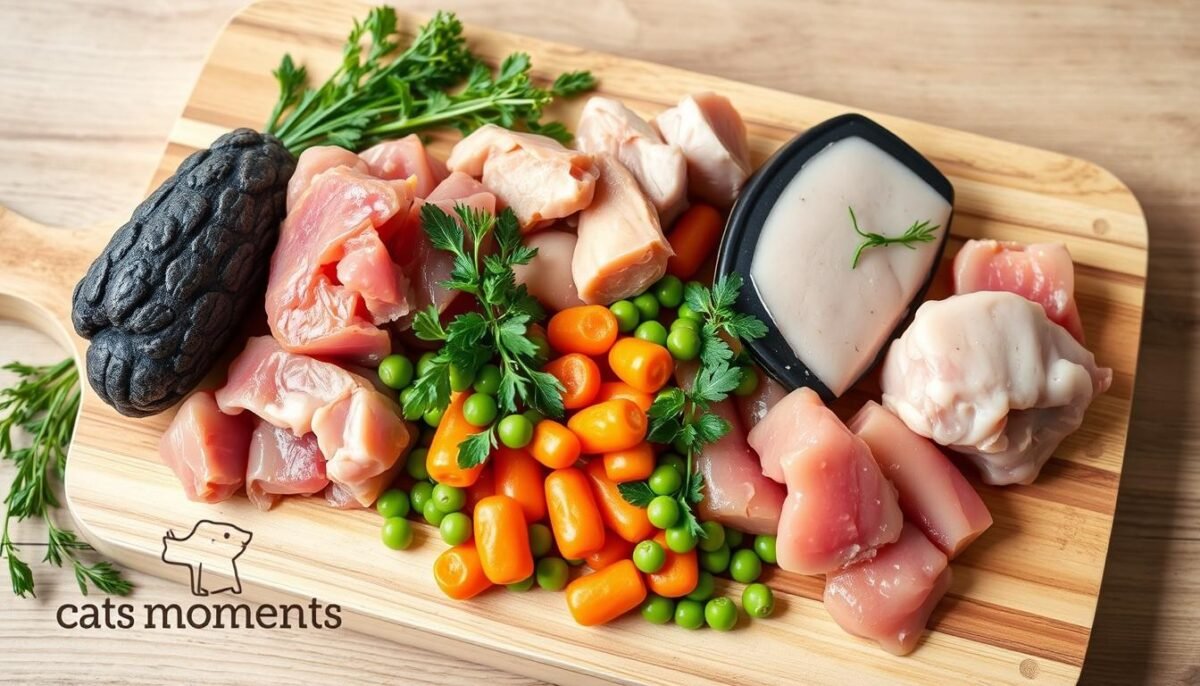
“Feeding a raw cat diet requires careful planning and execution to ensure the health and safety of our feline companions.”
Final Thoughts on Homemade Cat Food
Homemade cat food is a big decision for our feline friends. It means we choose fresh, healthy meals for them. This way, we make sure they get the best care possible.
Making Informed Choices for Our Cats
Homemade cat food lets us control what our cats eat. We learn what they need and avoid bad stuff. This helps us keep them healthy and happy for a long time.
Long-Lasting Benefits of Homemade Diets
Homemade cat food does more than just feed them. It helps keep them healthy for years to come. This can even help prevent common health problems. It’s a big step for our cats’ well-being.
Empowering Ourselves as Responsible Pet Owners
Preparing homemade cat food is good for our cats and for us. It makes us more involved in their care. We learn more about their needs and our bond grows stronger. This shows our dedication to their health and happiness.
FAQ
What are the benefits of homemade cat food?
Making homemade cat food has many advantages. It gives our cats better nutrition and lets us choose what they eat. This way, we can make sure their diet is natural and balanced.
What are some common ingredients used in homemade cat food?
Homemade cat food should include lean proteins like chicken, turkey, or fish. We also add vegetables and grains like brown rice and sweet potatoes. Don’t forget to add supplements for all the vitamins and minerals they need.
How can we ensure the safety of homemade cat food?
Keeping homemade cat food safe is key. We must follow good hygiene, avoid harmful ingredients, and store food properly. Talking to our vet can help us keep our cat’s diet safe.
Where can we find recipes for homemade cat food?
We’ve got easy recipes for homemade cat food. You can try a chicken and rice dish, a tuna and pumpkin delight, or a beef and vegetable medley. These recipes are balanced and tasty for cats.
How do we transition our cat to a homemade diet?
Introducing homemade food to our cats should be done slowly. Start by mixing a little new food with their old diet. Gradually increase the new food over time. Watch how your cat reacts and adjust as needed.
What equipment do we need for preparing homemade cat food?
To make homemade cat food, you’ll need a food processor, blender, and containers. Also, have clean cutting boards and utensils for safety.
Is homemade cat food more affordable than commercial options?
Often, homemade cat food is cheaper than buying commercial food. By choosing affordable ingredients, we can save money. Plus, it’s better for our cat’s health.
When should we consult a veterinarian about our cat’s homemade diet?
It’s crucial to talk to our vet when switching to homemade food. They can help with nutrition plans and check our cat’s health. Regular vet visits are important for a balanced diet.
What are the pros and cons of a raw cat food diet?
Raw cat food diets have good points and risks. They might offer nutritional benefits but need careful safety and balance. Always discuss this with our vet.
